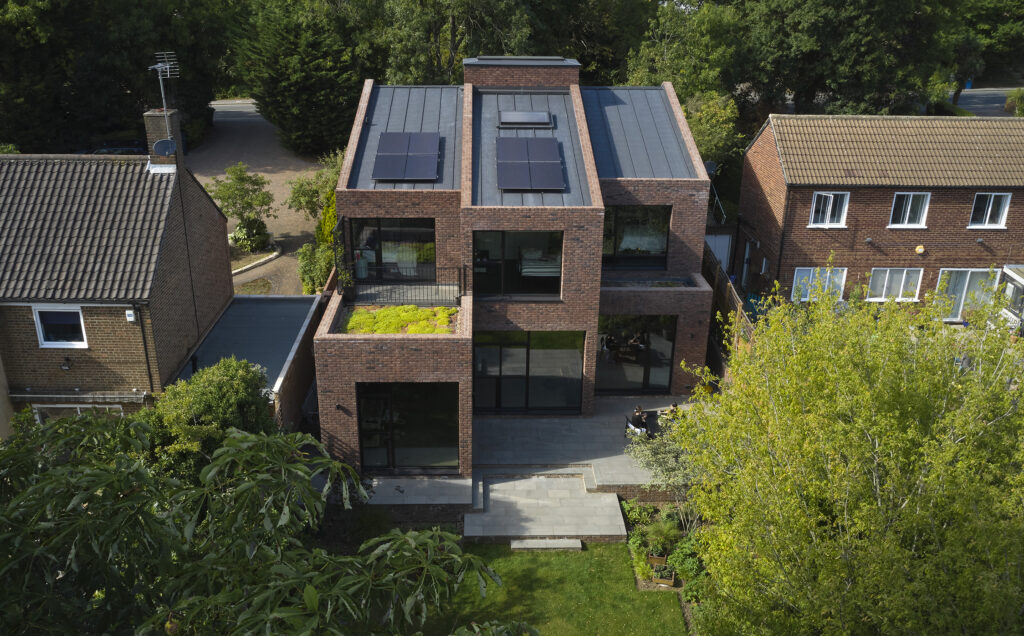We’ve all seen those captivating TV shows that showcase the creation of stunning dream homes. The design and construction process often steal the spotlight, leaving behind the less glamorous but crucial step of obtaining planning permission. While it may lack the drama of heated planning committee meetings, securing planning permission is undeniably the most important milestone on the path to building a new house.
In this comprehensive guide, we’ll delve into the nitty-gritty of the planning permission process, equipping you with the knowledge and insights necessary to navigate this crucial stage with minimal hassle. From understanding the definition of a new build house to engaging the right professionals, we’ll cover it all. So let’s dive in and unravel the secrets of obtaining planning permission for your new build or self-build house.
Defining a New Build House
Before we dive into the intricacies of planning permission, let’s clarify what we mean by a new build house. Essentially, a new build house refers to a residential building that did not exist previously in any form. It excludes conversions or changes of use of existing buildings. You’ve probably come across this term before, as new build houses are frequently discussed in the news. The UK government has been actively promoting the construction of new build houses to meet the growing demand for housing. A new build house encompasses everything from the foundations and structure to the fixtures, fittings, and essential facilities like water, gas, and electricity, as well as access to and from the property.
Why Self-Build Homes Matter
Next, let’s explore the concept of self-build homes and why it’s crucial for aspiring homeowners. According to the government’s definition, a self-build home is one in which the owner has a significant input into its design. Interestingly, the UK lags behind many similar countries in terms of providing opportunities for people to participate in designing their future homes. As a prospective self-builder, you can register with your local council, which not only keeps the pressure on the council to grant planning permission for self-build projects but also encourages negotiations with large landowners to make suitable plots available.
It’s important to note that being a self-builder alone does not guarantee planning permission. However, it does increase the likelihood of a favorable consideration by the council, especially if they are far from meeting their self-build targets. So, if you’re envisioning a self-build project, registering as a self-builder and understanding the associated opportunities and challenges is an essential step.
Demystifying Planning Permission
Now, let’s demystify the concept of planning permission. When you obtain planning permission, the local authority grants you the rights to construct a specific property of a certain size on a designated plot. To obtain planning permission for a new build or self-build house, you’ll need to submit a well-crafted planning application with the assistance of professional architects and planning consultants.
It’s crucial to understand that planning authorities consider only certain issues, commonly known as “material planning considerations,” when reviewing an application. These considerations vary from case to case, and it’s up to the planning authority to weigh their significance in your specific project. Here are some examples of material planning considerations that may be relevant to your project:
- Loss of sunlight
- Overlooking and loss of privacy
- Noise or disturbance
- Capacity of physical infrastructure
- Effect on listed buildings and conservation areas
- Layout, density, and visual appearance of the building design
- Overshadowing and loss of outlook
- Highway issues, including traffic generation and vehicular access
- Smell or fumes
- Impact on trees
- Incompatible or unacceptable uses
- Storage or handling of hazardous materials and development of contaminated land
It’s important to note that your project must adhere to both national and local policy requirements. Conducting thorough research and understanding these policies will help you navigate the planning permission process more effectively.
The Power of an Exceptional Architect
As you embark on your journey to obtain planning permission, enlisting the help of professionals is crucial. A skilled architect can be your greatest asset in this endeavor. Their expertise and guidance are invaluable in translating your ideas into a tangible design and navigating the intricacies of the planning process. A knowledgeable architect will listen attentively to your needs and concerns, taking note of your pain points and desired outcomes. With their deep understanding of the planning process and experience in dealing with local planning authorities, architects can offer tailored solutions that align with your vision while complying with the council’s requirements.
Moreover, a skilled architect can create a design that transforms a seemingly challenging plot into one that receives the council’s approval. They can advise you on the best materials to use, increasing the likelihood of a successful application. Collaborating with an exceptional architect ensures that your goals are met while adhering to the standards set by the planning authority. Importantly, their professional services often result in cost savings that outweigh their fees.

Beyond Architects: Specialist Consultants
Depending on the specific concerns raised by the council or neighbors, you may need to engage various specialist consultants to support your planning application. These professionals bring their expertise to address specific aspects of your project and provide necessary assessments. Here are some examples of specialist consultants you may require:
- Transport consultants
- Tree consultants
- Ecology consultants
- Daylight/sunlight consultants
- Flood risk assessors
- Energy consultants
- Heritage consultants
While the costs of involving specialist consultants may seem daunting, their input is often crucial to overcome potential objections and reassure the council about the viability and impact of your new home. They provide expert assessments and ensure that your proposal aligns with the council’s requirements.
Pre-Application: To Consult or Not to Consult?
Many local councils offer pre-application advice services, though the extent of these services may vary for smaller projects. Availing yourself of this opportunity can prove extremely useful. In some cases, you can have a phone conversation with the duty planner to gauge the council’s initial response to your proposed project. Sharing professional designs during this stage can provide the council with a clearer understanding of your vision and help them provide relevant feedback.
While a pre-application consultation is often beneficial, it can also lead to unnecessary delays. Experienced architects and planners can guide you on when a pre-application is worth pursuing, taking into account the specific requirements of your council and project.
Exploring Different Types of Planning Permission
It’s important to understand that obtaining planning permission for a new build house doesn’t automatically mean you’re ready to start construction. The type of planning permission you seek and receive determines your next steps. Let’s examine the two main types of planning permission:
- Outline Planning Permission: This preliminary permission allows you to test the feasibility of your proposed project before investing in detailed plans and specialist reports. It provides an initial indication of whether your plans align with the council’s vision and regulations.
- Full Planning Permission: This detailed permission brings you much closer to commencing construction. Once you’ve secured full planning permission and the council has signed off on any included conditions, you can proceed with building the exact design detailed in your plans. Achieving full planning permission requires careful consideration of all relevant factors, from local planning restrictions to your desired outcomes.
The Application Process and What to Expect
When your architect has finalized the plans and received your approval, it’s time to submit the application to the relevant planning authority. Keep in mind that there will be a fee associated with the submission, and you can use online calculators to estimate the amount.
The waiting game begins once your application is submitted. Although the council is expected to reach a decision within eight weeks, it often takes longer. During this time, the planning authority will:
- Assess the site: The case officer may conduct a site visit or rely on photographs and satellite maps to evaluate the location.
- Review your designs: They will carefully examine the details of your proposed project.
- Consider the impact on the neighborhood: The council will evaluate how your development might affect the surrounding area.
- Evaluate compliance with policies and design guidelines: Your proposal will be cross-referenced against existing policies and design guides to ensure alignment.
The council’s decision-making process aims to be fair and thorough. Some councils actively engage with applicants to improve proposals and address any concerns, while others simply provide a yes or no answer. If your application is rejected, you have the option to appeal the decision. This involves a planning inspector, an impartial party unconnected to your council, reviewing your case. While it’s always preferable to get it right the first time, appealing can provide a fresh perspective and potentially secure the approval you deserve.

Understanding Planning Conditions
It’s important to note that obtaining planning permission does not mark the end of your engagement with the planning department. Every consent comes with conditions that must be met before construction can commence. These conditions may involve providing additional information or samples to satisfy specific requirements. It’s crucial to factor in the time required to address these conditions when estimating your overall project timeline.
Navigating Planning Permission as a Developer
If you’re a developer embarking on a project involving multiple new build houses, you’ll face additional challenges. While the underlying principles of the planning decision remain the same, the scale of your development amplifies certain considerations. Factors such as parking provisions and traffic management become more critical when constructing multiple properties. It’s essential to account for the needs and rights of neighboring residents to ensure a peaceful construction process.
As a developer, working with a skilled architect becomes even more imperative due to higher costs and greater risks. It’s crucial to familiarize yourself with the intricacies of obtaining planning permission for large-scale new build projects before submitting your application.
RISE Design Studio: Your Partner in Obtaining Planning Permission
At RISE Design Studio, we boast a team of talented architects ready to transform your dreams into reality. With our extensive experience and expertise, we can guide you through the planning permission process with confidence. Don’t hesitate to contact us today and embark on your journey towards obtaining planning permission for your new build or self-build house.
If you would like to talk through your project with the team, please do get in touch at mail@risedesignstudio.co.uk or give us a call on 020 3290 1003
RISE Design Studio Architects company reg no: 08129708 VAT no: GB158316403 © RISE Design Studio. Trading since 2011.
